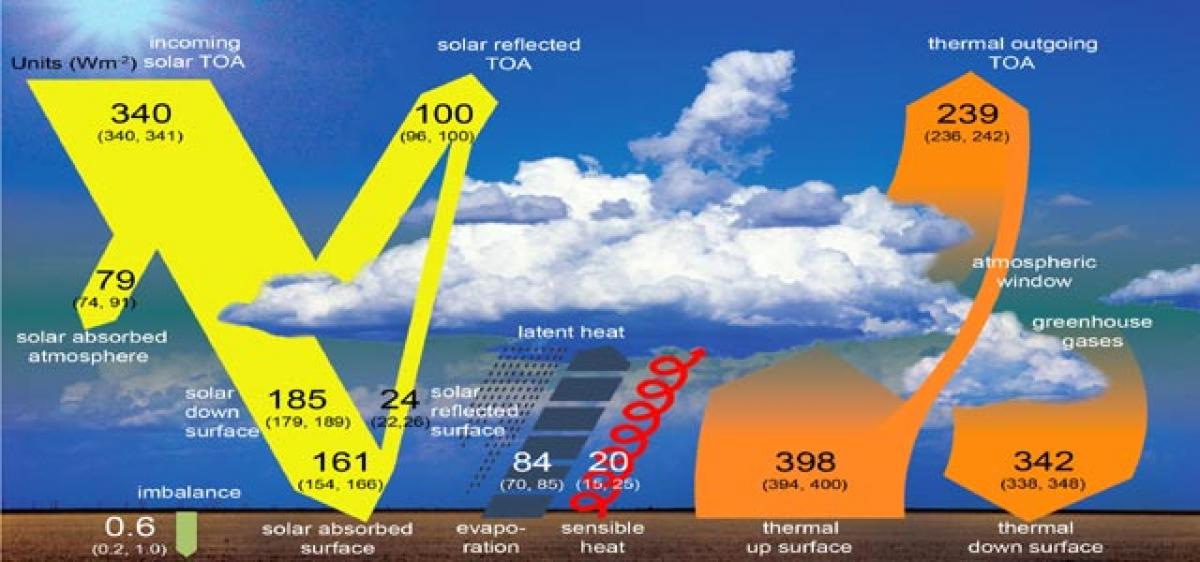Live
- CM Revanth Reddy Congratulates Telangana Athlete Deepti Jeevanji for Arjuna Award Selection
- China adds 10 US companies to unreliable entities list
- Telangana Government Announces January 3 as 'Women Teacher's Day' to Celebrate Savitribai Phule's Legacy
- Mithali Raj Supports AP’s Social Media Kindness Campaign
- Sajad Lone files PIL for fair police verification and rights of citizens
- Global Type 1 diabetes market to reach $9.9 bn by 2033: Report
- Record on New Year’s Eve, KSBCL Records Over Rs. 308 Crore in Liquor Sales
- Software Engineer from Hassan Dies by Suicide
- BJP is Politicising Contractor’s Suicide Case to Target Priyank Kharge- Bhandari
- India’s Solar Revolution, Surya Ghar Muft Bijili Yojana to Transform Energy Sector
Just In

The reassurances given by the Union Environment Minister that India would start preparing for Paris Agreement implementation from 2017, notwithstanding, the Union Budget did not provide any boost for climate change.
The reassurances given by the Union Environment Minister that India would start preparing for Paris Agreement implementation from 2017, notwithstanding, the Union Budget did not provide any boost for climate change. India is committed to United Nations Framework Convention on Climate Change (UNFCCC) and Kyoto Protocol, which represent international consensus on the ways to deal with climate change.
New Delhi has a comprehensive framework of legal and institutional mechanisms to respond to environmental challenges. It has initiated several climate-friendly measures, particularly in the area of renewable energy besides inking the Paris deal, which calls on countries to combat climate change and limit global temperature rise to well below two degrees Celsius.
The Paris climate conference brought into sharp focus the hazards of runaway climate change. India announced its new climate plan, also known as its Intended Nationally Determined Contribution (INDC). It is the world’s third-largest emitter of GHGs—the share stands at around 4 per cent—and is highly vulnerable to impacts of climate change.
India is committed to invest in tackling climate change while addressing poverty, food security and access to healthcare and education. The action plan also prioritises efforts to build resilience to climate change impacts, and gives a broad indication of the amount of financing necessary to reach its goals.
India’s plan to reach the INDC needs to be strongly gender-equitable and community based. The country needs to strongly push for Climate Technology Centre and Network (CTCN) in order to have improved capacity that would help in generating good adaptation action plans and proposals. According to the latest BP Energy Outlook, demand for green energy is expected to grow by seven times in 2035, which means the share of renewable energy in the country’s fuel mix will increase from 2 per cent to 8 per cent in 2035.
However, coal and other fossil fuels will continue to play a major role in India’s energy mix in the decades to come. By 2050, more than six billion people of the world will live in urban areas, creating a pressing need for a host of infrastructure services, like water and sanitation. Around, 400 million homes are expected to be built by 2020, a potential boon for construction companies that can incorporate green technology into their builds.
There are great opportunities in climate-smart financial solutions (Dimitris , Capital Finance magazine, IFC, January 6, 2016). India’s INDC recognises the importance of aggressively restoring forest cover, in a manner consistent with supporting livelihoods. Creating an additional carbon sink of 2.5 to 3 billion tonnes of CO2 would require average annual carbon sequestration to increase by at least 14 per cent over the next 15 years relative to the 2008-2013 period.
That is a tall order. Apart from Green India Mission—expected to deliver 50-60 per cent—it remains to be seen how India will achieve the rest. Moreover, INDC lacks of clarity on emissions intensity in the base year (2005) and target year (2030), as well as the scope and coverage of the intensity target and the methodologies for measuring it. This information is crucial for monitoring progress towards India’s target and for understanding how it contributes to the global goal of limiting temperature rise to 2 degrees C.
As a country exceptionally vulnerable to climate change, there is heavy focus on adaptation and resilience in India’s INDC. INDC emphasise investment in these activities would require additional support through domestic and international funds. It is estimated that the country would need US $206 billion during 2015-2030, with additional investments needed for disaster management (5 Key Takeaways from India’s New Climate Plan by Apurba Mitra, et al, World Resource Institute- October 05, 2015).
It is reported that the accelerated warming of the Arctic and the Antarctic could trigger catastrophic climate changes and the world has recently received dire warnings about the deteriorating health of our planet from two of its most fragile and critical ecosystems. Artic Resilience report recently warned that the accelerated warming of Artic could trigger “tipping points which in turn lead to “catastrophic and uncontrollable climate changes” (Stop before the tipping point, Hindustan Times, January 12, 2017).
For India that has extensive coastline, the implications are enormous. The Union Environment Minister announced in December 2016 that India would start preparing for implementing the Paris Agreement from 2017. However, there is no major boost for climate change in Union budget 2017-18. The ministry seems confident to spend large sums in preparing to implement the Paris Agreement that comes into force from 2020. (Courtesy: www.downtoearth.org.in)
By Samar Lahiry

© 2024 Hyderabad Media House Limited/The Hans India. All rights reserved. Powered by hocalwire.com







